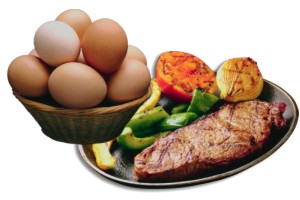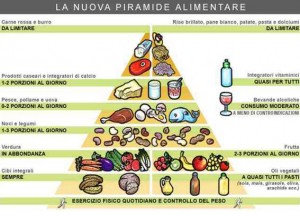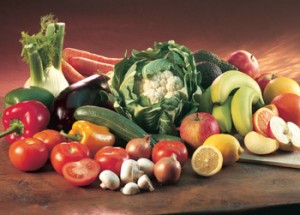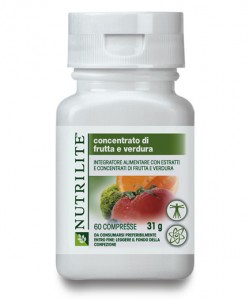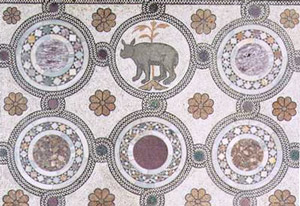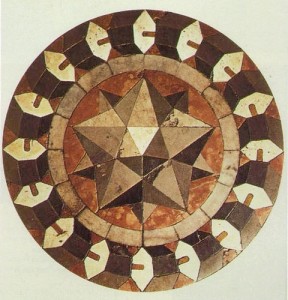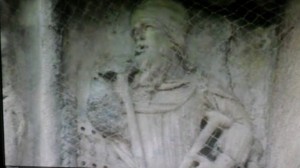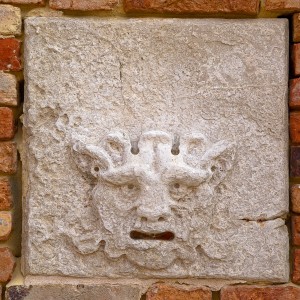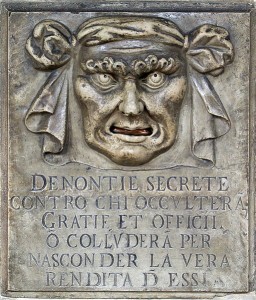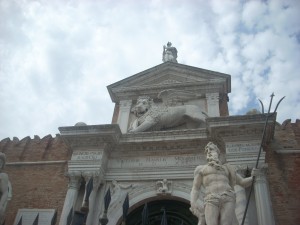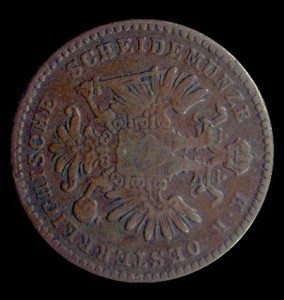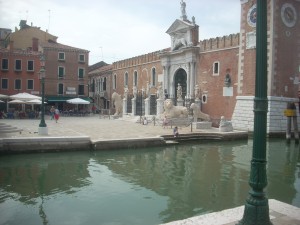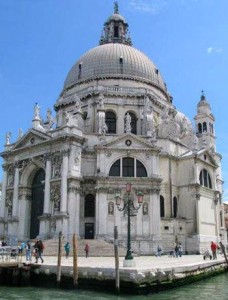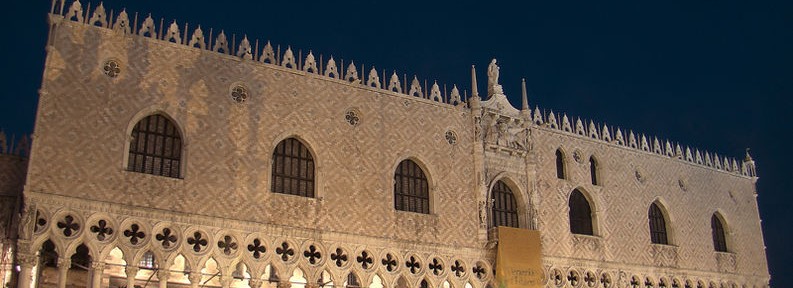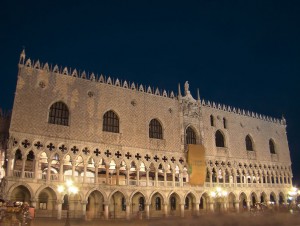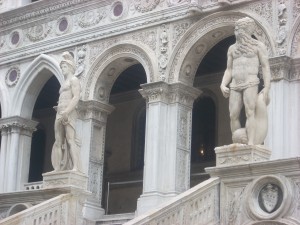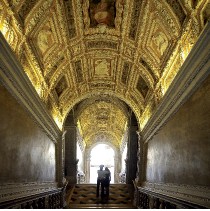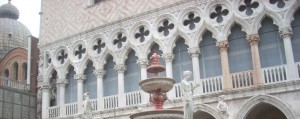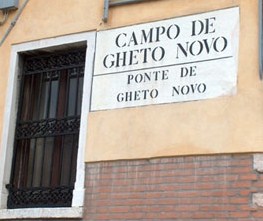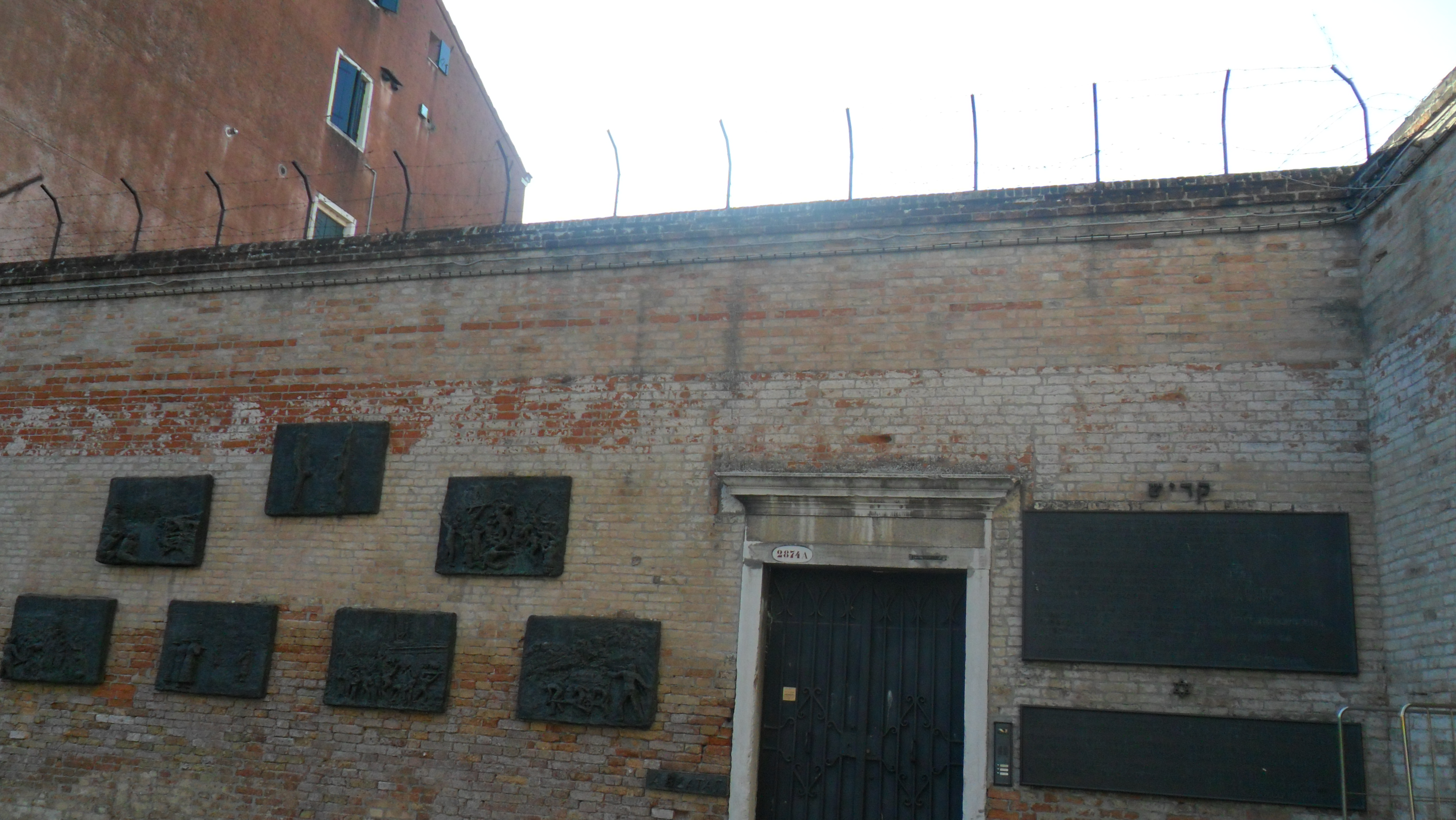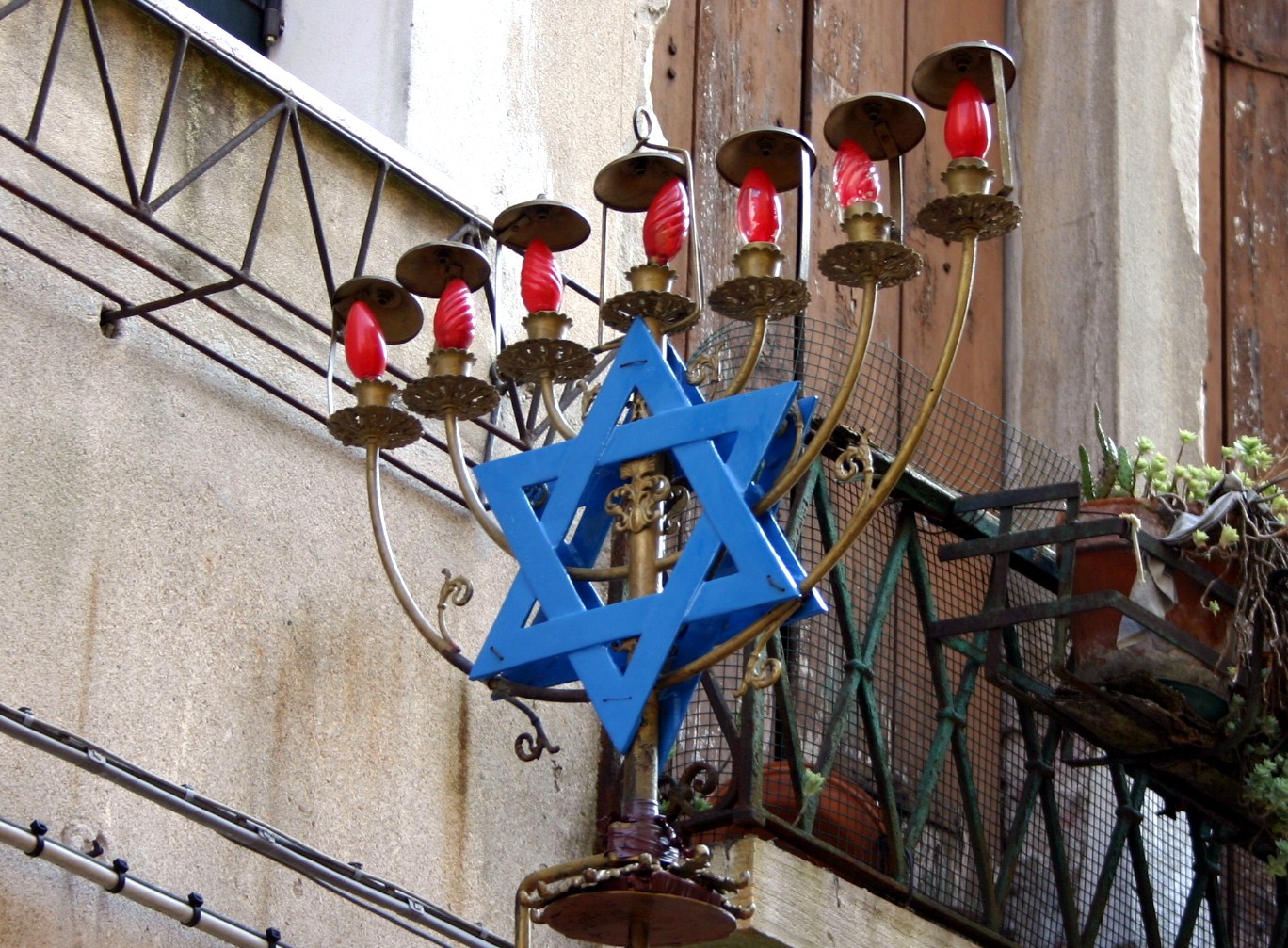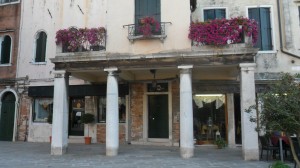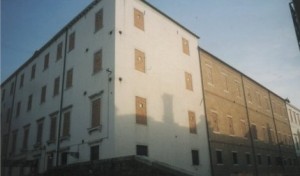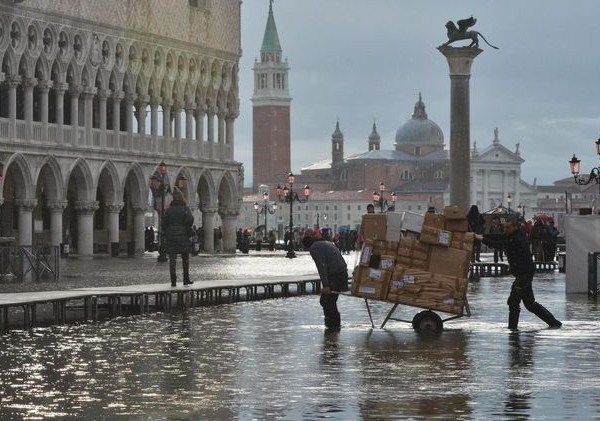Saint Lucia – the Latin name lux ,luce -“light” was associated with “the light way “, “the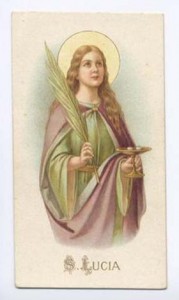 path of light” , or “born at the rising of the light” ( sunrise ) “,then LUCIA -brightness,the lightest.
path of light” , or “born at the rising of the light” ( sunrise ) “,then LUCIA -brightness,the lightest.
On the majority of the sources ,the date of his born” Dies Natalis ” :is December 13, (although in the mysterious Latin calendar of Sinai her ” Dies Natalis ” falls on February 8.)
December 13 was , indeed, the darkest day of the year ,the winter solstice ,and around that date ,Roman paganism already celebrated a goddess named Lucina , hence the theory that all the Christian holidays (such as that of Agatha ) would be imposed of pre-existing pagan cults .
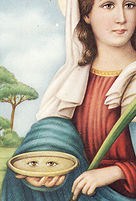 But, what are the causes of the proliferation of Santa Lucia ,like protector of the view ?The episode of Lucia tearing eyes is unfounded , and absent in the multiple narratives and traditions, (at least until the fifteenth century ) . The emblem of the eyes on the cup , or on the plate ,are, simply, popular devotion .Like protector of the view has always invoked because of his name Lucia ( from latin lux – light). We can talk about “expansion of the act of reading iconographic imagery” . On the paintings Lucia holds in his hand (or on a plate or on a tray ),two eyes, which is often accompanied by the lamp ( one of the most popular evangelical symbols and more beautiful, perhaps derived from the burial art ) Is for this reason that the iconography of Santa lucia, from the sec . XIV, is an interpreter and popularizer of this legend , depicting the saint with specific symbols that are missed before the modern references to its physiognomic data , for which artists were accustomed to resort to the Golden Legend of James of Voragine , which is the reference text and the source of much of the religious iconography .
But, what are the causes of the proliferation of Santa Lucia ,like protector of the view ?The episode of Lucia tearing eyes is unfounded , and absent in the multiple narratives and traditions, (at least until the fifteenth century ) . The emblem of the eyes on the cup , or on the plate ,are, simply, popular devotion .Like protector of the view has always invoked because of his name Lucia ( from latin lux – light). We can talk about “expansion of the act of reading iconographic imagery” . On the paintings Lucia holds in his hand (or on a plate or on a tray ),two eyes, which is often accompanied by the lamp ( one of the most popular evangelical symbols and more beautiful, perhaps derived from the burial art ) Is for this reason that the iconography of Santa lucia, from the sec . XIV, is an interpreter and popularizer of this legend , depicting the saint with specific symbols that are missed before the modern references to its physiognomic data , for which artists were accustomed to resort to the Golden Legend of James of Voragine , which is the reference text and the source of much of the religious iconography .
Become master of Syracuse , blind, eye doctors , electricians, against eye diseases .
The acts of the martyrdom of Lucia of Syracuse were found in two ancient and diverse sources: one in the Greek text of which the oldest dates back to centuries V; the other , in Latin,from the end of the century. V which seems to be a translation of the Greek one. The oldest Greek preparation of the martyrdom contains a hagiographic (relative to the saint’s life ) legend , reworked by an anonymous ,two centuries after her martyrdom on the oral tradition, from which it is still trying to establish the historical data.
While there were ,who has staunchly defended , admitting both the historicity of the martyrdom and the legitimacy of worship; from the other side there are those who has completely blamed , considering the narrative a mere contrivance imaginative of the narrator and with the absence of any cure for historical accuracy .
The martyrdom begins with a visit of Lucia ( whose father belongs to a rich family of Syracuse) and her mother Eutichia , to the tomb of Agatha, in Catania , to plead for the cure of the disease from which his mother was suffering : an unstoppable flow of the blood. Lucia , urges the mother to approach of the tomb of Agata and touch it with ” absolute faith ” and ” blind faith ” in the miraculous healing that the virgin martyr was capable of giving. At this point,Lucia , is taken from a deep sleep that leads her to a dream-like vision in which appears Agatha , and informed her of the healing of her mother and also predicts his future martyrdom , which will be the glory of Syracuse as well as Agatha had been for Catania.Lucia communicates to her mother her decision : to consecrate themselves to Christ! To this end, also asks to return her dispose and her assets to charity ( was promised in marriage to a pagan .) However, just during the return trip, Lucy succeeds , with its insistence, to convince his mother , to donate the parental assets to charity , which the virgin, initiate just arrived in Syracuse.
 However , the news of the alienation of his father’s wealth comes immediately aware of the betrothed of the virgin, that it shall ascertain precisely with Eutichia which also asks the reasons for the sudden and unexpected decision .The woman made him believe that the decision was linked to a very profitable investment , and drove him to cooperate in the sale of the goods.Later, the boyfriend of Lucy, perhaps exacerbated by the continual postponements of marriage, decides to report to the governor (Paschasius ) the Christian choice of his fiance( were applicable the decrees issued by the Emperor Diocletian about the persecution of the Christians ) . After the questioning the virgin “manages to argue with
However , the news of the alienation of his father’s wealth comes immediately aware of the betrothed of the virgin, that it shall ascertain precisely with Eutichia which also asks the reasons for the sudden and unexpected decision .The woman made him believe that the decision was linked to a very profitable investment , and drove him to cooperate in the sale of the goods.Later, the boyfriend of Lucy, perhaps exacerbated by the continual postponements of marriage, decides to report to the governor (Paschasius ) the Christian choice of his fiance( were applicable the decrees issued by the Emperor Diocletian about the persecution of the Christians ) . After the questioning the virgin “manages to argue with
the strength and security of those who are inspired by Christ”, but the governor
imposes the penalty of prostitution,and subjecting it to a kind of exorcism to expel ” the evil Spirit .”The virgin , tells him that his mind will not give up but if the body subjected to torture ,will turn against her mind , she will remain chaste, pure and untouched in spirit and mind.At this point there was a prodigious event: the virgin becomes immovable and steadfast and , no attempt fails to deliver her to give in, even the magicians specially convened by the ruthless Paschasius .Exasperated by such an extraordinary event , the governor ordered to burn her , but the fire even manages to not burn it. Lucia perish by the sword ! So , bend on her knees ,the virgin waiting for the final blow and , after having
prophesied the fall of Diocletian and Maximian, was beheaded.
An Syracuse popular tradition ,said that after his last breathe, the body of Lucia was devoutly buried in the same place of martyrdom. In fact , according to the devotion of her countrymen , the body of the saint was placed in a niche carved into the tufa on the catacombs used as a tomb.
In the year ‘ 878 Syracuse was invaded by the Saracens and the citizens took away her body from there and hid it in a secret place to escape the fury of the invaders. It was then brought from Syracuse to Constantinople in ” a silver casket .” During the crusade of 1204 , the Venetians carried him to the monastery of St. George in Venice. Santa Lucia were elected the patron of the city , building a great church , where the body was kept until 1863, when it was demolished for the construction of the train station (which is called VENICE SAINT LUCIA )
In the year 1860,the pope Pius IX did transfer the body in the church of Saints Jeremiah and Lucy, built with the material of the of the demolished church of St. Lucy were is venerated today. In 1955, the patriarch – Angelo (becamed Pope with the name John XXIII) -suggested that the remains will be covered with a silver mask to give more importance to the sacred relics of Saint Lucia .
 On April 4, 1867 the remains of Lucy were desecrated by thieves ( arrested ), which were introduced into the church , to take possession of the votive ornaments . Then in 1949 , the martyr , he was deprived of the crown ( in this case the thief was arrested ) , and in 1969 , two thieves broke the glass urn. On November 7, 1981 two attackers broke the casket and the body of the martyr extracting the head and the silver mask . The body was just recovered on December 12 , 1981, on the eve of the commemoration of the saint.
On April 4, 1867 the remains of Lucy were desecrated by thieves ( arrested ), which were introduced into the church , to take possession of the votive ornaments . Then in 1949 , the martyr , he was deprived of the crown ( in this case the thief was arrested ) , and in 1969 , two thieves broke the glass urn. On November 7, 1981 two attackers broke the casket and the body of the martyr extracting the head and the silver mask . The body was just recovered on December 12 , 1981, on the eve of the commemoration of the saint.
other items http://dipoco.altervista.org/
visit my website http://ginocosta.altervista.org/
